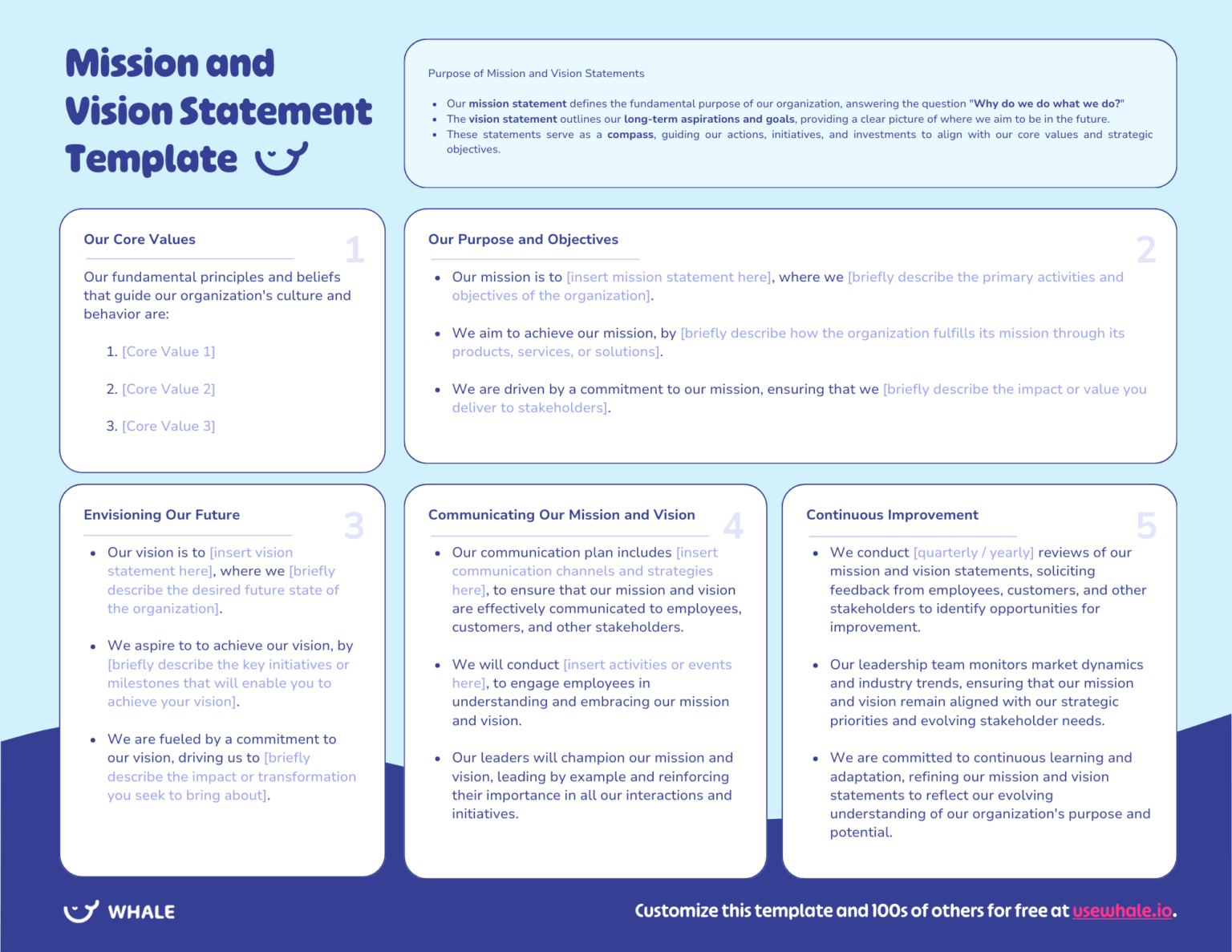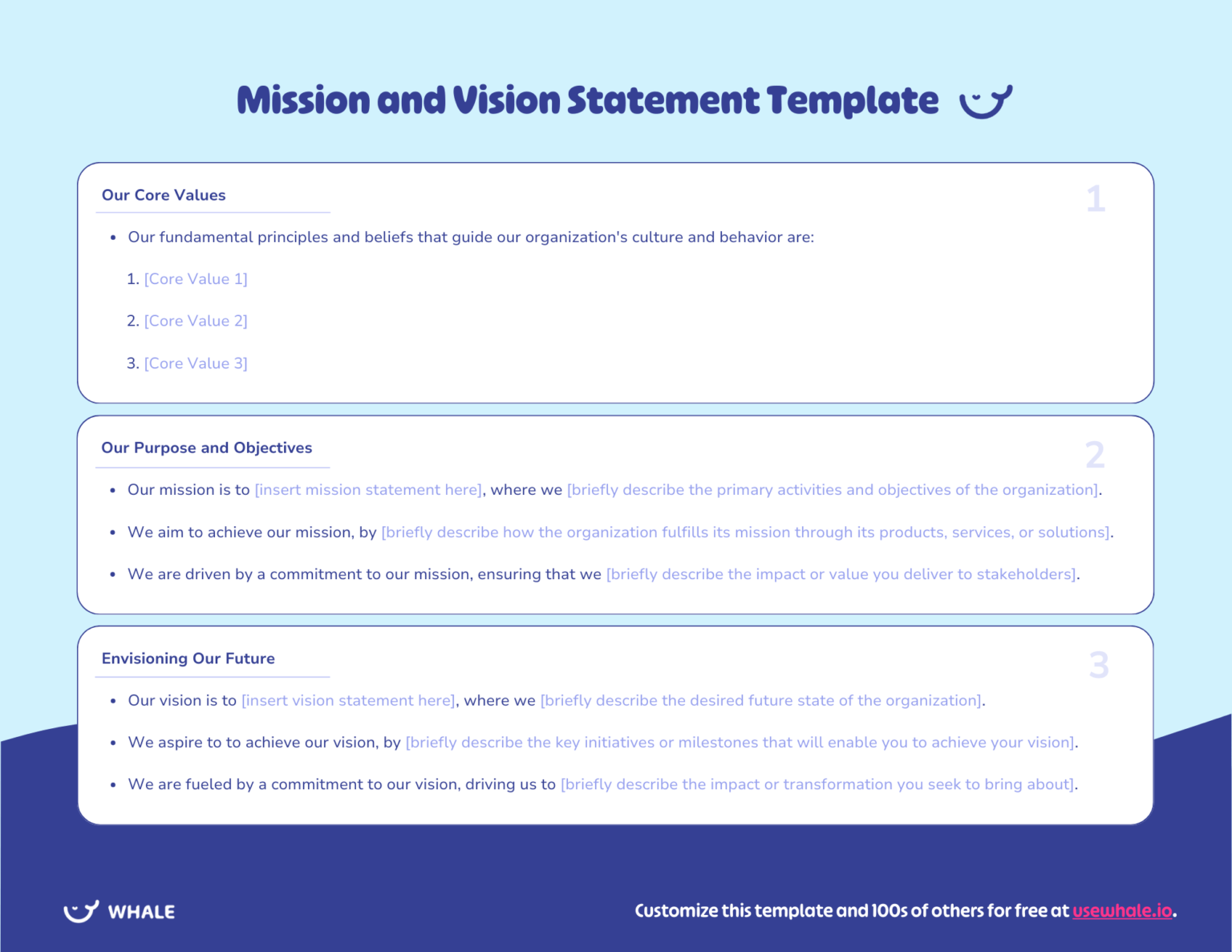Why is a mission and vision statement important?
The benefits of having clear and well-defined vision and mission statements are substantial for any business. These statements serve as foundational elements that guide strategic planning, decision-making, and overall business operations.
Here are some of the key benefits:
- Provides Direction and Focus: Vision and mission statements help clarify the purpose and primary objectives of your business. This helps keep everyone in the organization aligned and focused on common goals, guiding daily operations and long-term strategies.
- Enhances Strategic Alignment: These statements ensure that every aspect of your business is aligned with its core values and long-term objectives. This alignment is crucial for effective strategic planning and resource allocation.
- Improves Organizational Culture: A strong mission statement reflects the company’s values and supports a culture that aligns with these values. This can enhance employee morale and loyalty by creating a sense of shared purpose.
- Facilitates Better Communication: Clear, concise mission and vision statements provide a straightforward way to communicate the business’s goals to stakeholders, including employees, customers, investors, and partners. This transparency can build trust and credibility. Explanation of how these statements impact business strategy and corporate culture.
- Guides Decision Making: Having definitive mission and vision statements can help decision-makers avoid opportunities that do not align with the business’s core objectives, ensuring that the company remains true to its purpose and goals.
A clear mission attracts individuals will even attract top talent and those who feel a personal alignment with the company’s goals, aiding in recruitment and retention. Similarly, a persuasive vision statement can attract investment by showing potential investors the ambitious goals and growth potential of the business.
Understanding mission and vision statements
Mission and vision statements are not merely formalities; they are strategic tools that can drive a business toward success. These statements articulate a company’s purpose and aspirations, serving as a compass to guide strategy, decision-making, and operations.
- Mission Statement: A mission statement defines the current operations of a business — what it does, whom it serves, and how it serves them. It encapsulates the company’s core purpose and its approach to achieving it. The mission grounds the company, providing a steady focus for its day-to-day operations and tactical initiatives.
- Vision Statement: A vision statement, on the other hand, is future-oriented. It describes where the company aspires to be in the long-term future. This statement should be inspirational and aspirational, painting a picture of the future that motivates and guides stakeholders towards shared long-term goals.
What is a mission statement?
A mission statement is a concise explanation of a company’s reason for being. It answers the fundamental questions of any business:
- What do we do? It describes the products or services the company provides.
- Whom do we serve? It specifies the target audience or market.
- How do we serve them? It explains the approach or methods used in delivering its products or services.
The purpose of a mission statement is to clarify the business’s primary objectives and how it intends to achieve them. This clarity helps align the focus of all stakeholders and ensures that the company remains centered on its foundational goals, regardless of external changes or challenges.
Example of a mission statement
A mission statement might say, “Our mission is to provide innovative healthcare solutions that improve patient outcomes globally,” focusing on current actions and objectives.
What is a vision statement?
A vision statement outlines a company’s goals for the future. It is meant to inspire and provide a clear focus for strategic planning. A vision statement should:
- Be aspirational, aiming high and looking forward into what the company intends to achieve.
- Serve as a guide for choosing current and future courses of action that will aid in achieving these long-term goals.
Vision statements are designed to be bold and motivating. They are less about where the company is at the moment and more about where it wants to be. This forward-looking perspective is essential for driving innovation, attracting talent and investment, and inspiring stakeholders to support the company’s growth and development.
Example of a vision statement
A vision statement could state, “Our vision is to transform the landscape of healthcare by achieving global leadership in sustainable and technology-driven care,” illustrating a future state the company aspires to reach.
What is the difference between a mission and vision statement?
Understanding the difference between a mission statement and a vision statement is crucial for any organization, as they serve distinct purposes and guide various aspects of business strategy and development. Here’s a breakdown of the key differences:
Purpose and Focus
- Mission Statement: Focuses on the present and defines the core purpose of the organization. It explains what the organization does, whom it serves, and how it serves them. The mission statement is about the here and now, detailing the organization’s primary objectives and the strategies to achieve them.
- Vision Statement: Looks to the future and describes what the organization aspires to achieve in the long run. It is aspirational, providing a clear picture of the future that the organization aims to create. The vision statement is intended to inspire and motivate stakeholders towards long-term goals.
Content and Scope
- Mission Statement: Typically operational in scope, a mission statement provides a concrete description of the business’s current activities. It outlines the company’s immediate goals and the means by which it intends to achieve them. This statement tends to be more grounded and practical.
- Vision Statement: Broad and abstract, a vision statement does not detail the means to achieve its ends but rather focuses on the desired end state itself. It is broader and more abstract, offering a vivid image of what success looks like for the organization years down the line.
Function and Impact
- Mission Statement: Serves as a foundational tool that influences daily operations and decision-making processes. It ensures that the organization’s activities are aligned with its core values and operational goals. It acts as a guide for behavior and helps maintain focus on the organization’s purpose.
- Vision Statement: Acts as a motivational tool that shapes the organization’s strategic planning. It provides a target for where the organization is heading, which helps in setting long-term objectives and strategies. The vision statement helps in rallying employees and stakeholders around a common long-term goal.
Use our templates to fast-track your documentation
Customize this template and 100s of others for free in Whale, the fastest way to get your team aligned.
How to write your mission and vision statements?
Writing compelling mission and vision statements involves a thoughtful process that encompasses the core values, strengths, and aspirations of your business. Here’s a detailed guide on how to craft these critical statements effectively:
Key considerations before you begin
Identify your core values
These are the principles that guide your business’s actions and decisions. Identifying these values helps ensure your mission and vision statements are rooted in what’s fundamentally important to your organization.
Understand your business's unique strengths
Recognize what sets your business apart from the competition. This could be your innovative technology, exceptional customer service, or unique product features.
Recognize your target audience and market position:
Knowing who your customers are and understanding your position in the market helps tailor your mission and vision statements to appeal directly to your intended audience and reflect your market role.
Questions to ask before starting
There are a 4 key questions to ask before you draft your mission and vision statement. These include;
- What do we do? (For mission)
- Why do we do it? (For mission)
- Where do we aim to be? (For vision)
- How do we envision our future? (For vision)
How to write a mission statement?
Here’s a step-by-step guide to formulating a concise and effective mission statement.
Mission Statement Guide:
Steps to create a concise and impactful mission statement:
- Start with your core activity: What primary service or product do you offer?
- Include why this activity is important: What value does it provide to your customers or the community?
- Consider adding how you do it uniquely, reflecting your core values and strengths.
Examples of effective mission statements:
- “To provide innovative solutions that improve the way communities live, work, and play.”
- “We deliver exceptional software experiences by driving technological innovation tailored to our client’s needs.”
Common pitfalls to avoid:
- Being too vague or broad, which can dilute the purpose of your business.
- Overloading the statement with jargon or buzzwords that may not be meaningful to all stakeholders.
- Making it too lengthy; a mission statement should be concise and to the point.
How to write a vision statement?
Here are the step-by-step instructions for crafting a visionary and aspirational statement.
Vision Statement Guide:
Steps to develop an aspirational vision statement:
- Imagine the future success of your business: What does that look like in 5, 10, or 20 years?
- Think big—be ambitious but ensure your vision is realistic and achievable.
- Align this vision with your core values and strengths, ensuring it reflects where you want the company to go.
Examples of inspiring vision statements:
- “To be the leading provider of green energy solutions worldwide, empowering every household to achieve energy independence.”
- “Our vision is to reshape the way the world thinks about travel, making global exploration accessible and sustainable for all.”
Common mistakes to avoid:
- Being overly optimistic to the point of impracticality can make the vision seem unattainable.
- Failing to inspire; a vision statement should be motivating and uplifting.
- Not differentiating from competitors which can make your vision statement feel generic.
Simon Sinek on making your vision meaningful.
5 Ways to integrate your mission and vision into your business
Integrating your vision and mission statement into your company is crucial for steering your organization in the right direction.
If your vision and mission statements aren’t communicated to your team, they’re as usual as papers in a draw. And by communication we don’t just mean speaking about them once at the quarterly or annual business review.
For a vision and mission statement to be effective, they need to be lived and felt. It’s about making these elements part of your culture.
- Align your policies and procedures. Ensure that your company policies and procedures reflect the values and goals outlined in your vision and mission statements. This creates a consistent framework that supports your company’s objectives.
- Incorporate the vision and mission statements into employee training programs. This helps new and existing employees understand and embrace these core statements.
- Develop recognition programs that reward behaviors aligned with the company’s vision and mission. Recognizing these behaviors reinforces their importance and encourages their repetition.
- Integrate the vision and mission into performance review criteria. This makes it clear that these statements are not just formalities but integral to every employee’s role.
- Hiring Practices: Integrate the vision and mission into your hiring process. Assess how well candidates align with these values during interviews, making it a criterion for selection.
How to streamline your mission and vision statement template with Whale?

Streamlining your mission and vision statement development with Whale can make the process more efficient and organized. Whale helps create and manage SOPs and processes, making it ideal not only for crafting and refining important strategic elements but sharing them, too!
Here’s how you can utilize Whale to streamline this process:
Step 1: Get started in seconds
Use Whale’s AI Assist or templates such as the vision and mission statement templates to get started in seconds.
Invite contributions from team members who can add comments or edits in real time.
PS Whale includes version control, so there’s no mistaking old versions for new ones. Whale keeps everyone updated, aligned and on the same page.
Step 2: Review and Refine
Utilize the workflow capabilities or simply use comments to set up review loops where selected reviewers can provide feedback on the draft statements. This can help refine the statements to better align with the organization’s goals.
Step 3: Finalization and Implementation
Once finalized, store the official mission and vision statements in your dashboard on Whale. This makes it easy for everyone in the organization to access and reference them. You can even send them as assignments for everyone to complete. And if you want to check that your team has retained the knowledge, simply utilize the quiz function to create a test.
Step 4: Continuous Improvement
Set reminders or schedule reviews for the mission and vision statements using Whale’s task management features. This ensures that the statements remain relevant and are updated according to new strategic directions or changes in the business environment.
Using Whale in this way not only streamlines the process of creating and maintaining your mission and vision statements but also enhances organizational alignment and facilitates better communication and collaboration across the company.
FAQs about mission and vision statements?
What are the core elements of a mission statement?
The core elements of a mission statement are succinct yet powerful components that encapsulate your business’s essence and intentions:
- Purpose: Clearly states why the business exists and what it aims to accomplish, focusing on the present.
- Scope of Operations: Describes what the business does, including the key services or products it offers.
- Values: Highlights the guiding principles and ethical standards that direct the business’s actions and decisions.
- Target Audience: Identifies the primary customers or community that the business serves.
- Distinctive Competence: Specifies what makes the business unique, setting it apart from competitors.
A well-crafted mission statement effectively blends these elements to convey a clear and compelling picture of the business, guiding its strategies and uniting its stakeholders.
What are the core elements of a vision statement?
A compelling vision statement is built on core elements that make it both aspirational and actionable.
Here are the essential components:
- Aspirational Quality: It should paint a picture of the future that inspires and motivates, projecting what the organization aims to achieve long-term.
- Clarity: The statement must be clear and understandable to ensure that everyone, from stakeholders to employees, can grasp the organization’s future direction.
- Alignment with Values: It should reflect the company’s core values, ensuring that the envisioned future aligns with the principles that define the organization.
- Feasibility: While ambitious, the vision should remain realistically attainable, providing a practical target that the organization can genuinely strive to achieve.
- Uniqueness: Tailored specifically to the organization, it should highlight what makes the company distinct and how it stands out in its industry.
Crafting a vision statement with these elements ensures it’s not only a guiding star for the organization but also a beacon that draws others to your mission.
Use our templates to fast-track your documentation
Customize this template and 100s of others for free in Whale, the fastest way to get your team aligned.








